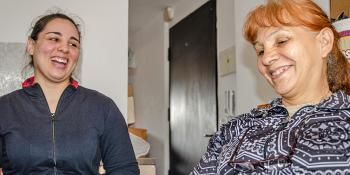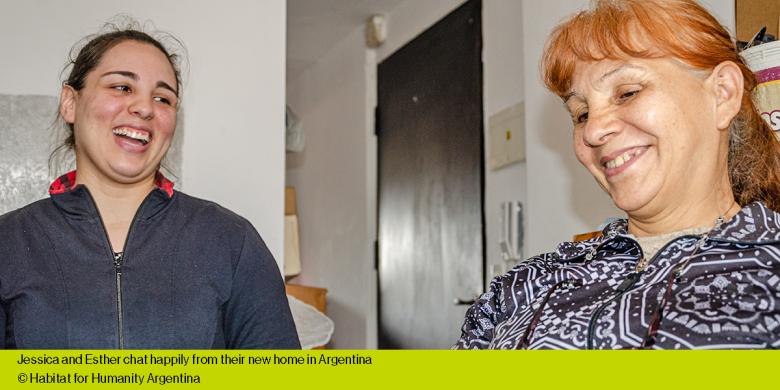
Finding light in a safe home
Finding light in a safe home
There were many things that Jessica disliked about the apartment where she lived with her mother and grandmother in La Boca, Argentina: the rats that nested in the roof and kept them up at night; the water, which wasn’t potable; the fact that the apartment scarcely protected them from the elements.
On rainy days, water would run into the house. “We couldn’t keep up with it… pots and buckets weren’t enough,” Jessica says, remembering how they would collect the water that dripped from the leaks in the ceiling. In the winter the house was exceptionally cold, and in the summer the wood would heat up, making it unbearably warm.
Worse still, the small quantity of water they had access to for the bathroom and kitchen wasn’t potable, so they couldn’t drink it or use it for cooking or washing. Nevertheless, what most bothered Jessica was how dark the apartment was, and how it was unsafe for her mother, Esther, and her grandmother, Amelia.
Esther is visually disabled and lived in constant fear that she would trip over things in the family’s apartment. Amelia, who has mobility issues, would spend most of the day in the darkness of her room.
Tired of living in these conditions, Jessica had spent four years searching for a safer home to move into but could not find anything she could afford that was also in decent condition. Her situation is shared by thousands of Argentineans across the country, where access to formal rentals is one of the main issues cities face. The rental market features a series of requirements that a large proportion of the population—much of which is employed by the informal market—finds challenging to meet.
In Buenos Aires, some 100,000 people must resort to the informal rental market to avoid becoming homeless. They are left with few options, mainly renting a room in a pension house, tenement house, or someone’s home, all of which are outside formal regulations and legal protections and represent risks to the renter’s health and quality of life.
Despite this reality, Jessica and her family refused to give up hope. One day, a friend told her about Habitat for Humanity Argentina’s Estela de Esperanzas building—a Habitat-supervised rental project built nearly 10 years ago in an old hotel and pension house.
The building includes nine apartments where families can access a safe home with affordable monthly payments on a three-year rental contract, which is standard in Argentina’s formal rental market.
The families that live in Estela de Esperanzas have received a gradual subsidy towards the cost of rent, which will be reduced on an annual basis. Additionally, they have the opportunity to participate in employability and entrepreneurship training developed by Habitat Argentina through partnerships with other organizations.
When she heard about the project, Jessica and her family felt overjoyed with the possibility of finally having found a new home. She quickly submitted an official application, and shortly after was informed that she had been selected to move into the building.
“It was the light at the end of the tunnel,” says Jessica.
Her new home has a bedroom, a living room, a full bathroom, a quaint balcony, and many windows that let natural light in from all sides of the home. “Getting out of that darkness and coming into this light was something… something so wonderful!” she exclaims.
The family can now bathe with clean, hot water instead of having to share it. They can cook in the winter without worries, and sleep through the night without being woken by the scratching of rats.
“We want to encourage families that find themselves in this same situation to not lose hope”— Jessica, from Argentina
